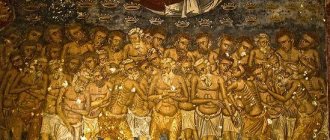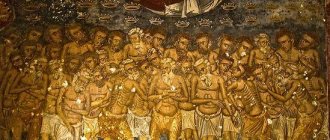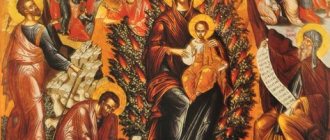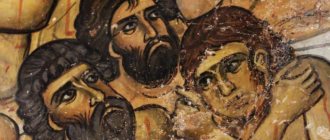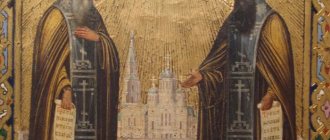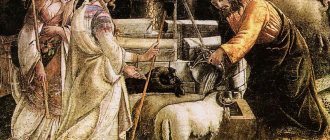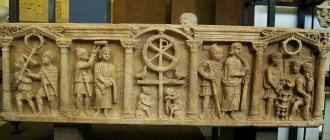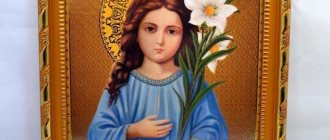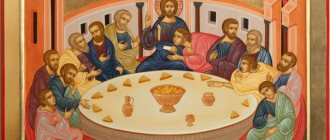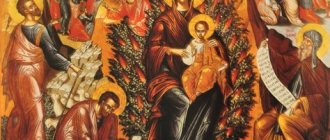Lives of the 40 Martyrs of Sebaste
The Forty Martyrs of Sebaste are the saints of the first centuries of Christianity. Their lives left a deep mark on the history of the faith of Christ. In 313, the Roman Emperor Saint Constantine the Great gave Christians freedom. But there was also a second ruler in Rome - Licinius. An ardent pagan, he not only planned to resume the persecution of believers in Christ, but also prepared to betray Constantine and become the sole emperor of Rome. The traitor decided to start the massacres with the military, among whom there were many followers of the Savior.
In the city of Sebastia there was just one of these - Christian - troops. Under the command of the pagan Agricolaus there was a whole squad of Christians - forty warriors, glorified by many victories. At the instigation of Licinius, Agricolaus tried to force them to sacrifice to the pagan gods, but they refused, for which they were thrown into prison. There the soldiers prayed to Christ, and it was revealed to them that “he who endures to the end will be saved.”
The next morning, the insidious Agricolaus again tried to persuade the army to renounce the Savior. But he failed the second time. Christians were again thrown into prison. A week later they were tried. The brave warriors answered the pagan court firmly: “Take not only our military rank, but also our lives, for us there is nothing more precious than Christ God.”
They wanted to stone the martyrs, but the cobblestones did not reach them - as if the Holy Spirit himself was protecting them from death. And again they imprisoned Christians. During prayer they heard: “He who believes in Me, even if he dies, will live. Be bold and do not be afraid, for you will receive imperishable crowns.”
Fresco of the temple of the Church of the Blessed Virgin Mary Asinu, Cyprus, 12th century. Photo by Maria Cherkashina
And so, when a frosty winter day arrived, the martyrs were led to a local lake and left there in custody, naked, right on the ice, where cold water splashed. A bathhouse was lit nearby so that in the agony of death the soldiers would renounce Christ and exchange Him for warmth... But only one of the sufferers could not stand it and ran to the bathhouse - and immediately fell dead in front of it.
In the morning, when one of the guards woke up, he saw shining halos above the heads of each of the thirty-nine Christians. Realizing why there were only 39 crowns, he exclaimed: “And I am a Christian!” — took off his clothes and stood next to the soldiers. In the morning, the soldiers and the guard were taken out of the lake and their legs were broken. Then their bodies were taken in chariots to the fire and burned.
When three days had passed after the execution, Bishop Peter of Sebastia saw the holy warriors in a dream - he was told to bury their remains. Together with his assistants, he collected the holy relics one by one and interred them with prayer.
Saints Equal to the Apostles
Equal to the Apostles are saints who, like the apostles, labored in converting countries and peoples to Christ. Such, for example, are Tsars Constantine and Helen (June 3), the baptist of Rus', Prince Vladimir (July 28), and Grand Duchess Olga (July 24).
Prince Vladimir, Baptist of Rus'
Images of saints equal to the apostles have basically the same iconographic symbolism; differences may be in the images of clothing that is characteristic of its time and people. Often in the iconography of saints equal to the apostles, the image of a cross appears - a symbol of baptism and salvation from eternal death.
Grand Duchess Olga
Temple of the 40 Martyrs of Sebaste
The Temple of the 40 Martyrs of Sebaste is located in Moscow near the Novospassky Monastery. The exact address of the temple: Dinamovskaya street, building 28.
In 1640, here on Taganka, Tsar Mikhail Fedorovich Romanov, the first tsar of this illustrious dynasty, determined that masons - the builders of the walls of the monastery and the monastery's Transfiguration Cathedral - would live here.
When the construction work ended, the masons did not go anywhere and settled here on Taganka. It was their craft that gave the name to two neighboring streets - Big and Small Masons. And soon, in 1645, not far from the entrance to the monastery, a new temple grew up - the 40 Martyrs of Sebaste.
Fresco of the temple of the Church of the Blessed Virgin Mary Asinu, Cyprus, 12th century. Photo by Maria Cherkashina
The ahistorical nature of the icon
There is a problem: should an icon be historically accurate, especially in its details? For example, ancient bishops did not wear either a panagia or a cross during divine services. In ancient images we always see St. Nicholas without them. The tradition of wearing crosses and panagias developed in the relatively late Middle Ages, and was widespread in recent centuries. Crosses appeared among the priesthood even later: among archimandrites at the end of the Middle Ages, and among parish priests already in the synodal period from the end of the 18th–19th centuries. Question: should we depict panagias and crosses as saints or not? Both approaches are possible: some believe that it is important to correspond to historical realities, others believe that the main thing is to create an image of a saint that is close to the perception of a contemporary, without going into details.
Hieromartyr Nikita, Pereslavl-Zalessky
The icon is in a sense ahistorical. Let us remember the icons of St. Spyridon of Trimythous: he is depicted in full episcopal vestments and with a shepherd’s cap on his head, which, of course, he did not wear in full vestments. But for the church tradition it was important to emphasize the humility and meekness that was deeply inherent in him, and also to show that he, already a bishop, remained a shepherd of dumb sheep. On the icon you can often find such “oddities” from the point of view of historical truth or the properties of linearity of time. For example, one mark on the icon of St. John Chrysostom may contain two of his figures at once - this emphasizes the numerousness and tirelessness of his care for the needs of his flock.
Let us remember the icons of church holidays, for example Pentecost. It depicts the descent of the Holy Spirit on the apostles, and always among the host of the apostles are Saints Paul, Mark and Luke. Moreover, it is known that they, at least the Apostle Paul, were not there at this historical moment of the birth of the Church of Christ and the descent of the Holy Spirit on the apostles. The Apostle Paul was not yet a Christian at all. But how can an icon show the Apostolic Church, which receives the Holy Spirit to enlighten us and the entire universe, without the supreme “apostle of the tongues” (nations) Paul and without the evangelist apostles of the 70 Mark and Luke? This is impossible. That is why they are depicted on the icon of the Feast of Pentecost, although from a historical point of view this is incorrect.
Even an icon of Christ can be perceived by someone literally, as a portrait, but the historian will always understand what is brought into the image by the rules of iconography. Christ, for example, extremely rarely held a scroll in his hands - only in synagogues, when the scroll of the Holy Scriptures was unrolled and He read aloud (see: Luke 4:16-21). However, Christ is often depicted on icons with a codex - a book - despite the fact that there were no books at all in those days. But the point is not historical accuracy; the icon reflects spiritual reality in images accessible to our perception.
Prayers to the Holy Forty Martyrs of Sebaste
First prayer
About the holy glory of the passion-bearers of Christ, the fourty, in the city of Sebastia, for the sake of Christ, who courageously suffered, through fire and water, and as the friends of Christ entered into the peace of the Heavenly Kingdom, have great boldness to intercede with the Most Holy Trinity for the Christian race: especially for those who honor your holy memory , and calling you with faith and love. Ask the all-merciful God for forgiveness of our sins and correction of our lives, so that in repentance and unfeigned love for each other, having lived with each other, we will boldly appear before the terrible judgment seat of Christ, and through your intercession we will appear at the right hand of the righteous Judge. To her, saints of God, be our protectors from all enemies, visible and invisible, so that under the shelter of your holy prayers we will get rid of all troubles, evils and misfortunes until the last day of our life, and thus we will glorify the great and venerable name of the all-powerful Trinity, the Father and the Son and the Holy Spirit, now and ever and unto ages of ages. Amen.
Second prayer
O passion-bearers of Christ, who courageously suffered in the city of Sebaste, we earnestly resort to you as our prayer books and ask: ask the All-Bounteous God for forgiveness of our sins and correction of our lives, so that in repentance and unfeigned love for each other, having lived together, we will boldly present ourselves to the terrible judgment of Christ and through your intercession we will stand at the right hand of the Righteous Judge. To her, God's servants, awaken us, God's servants (names), protectors from all enemies visible and invisible, so that under the shelter of your holy prayers we will get rid of all troubles, evils and misfortunes until the last day of our life, and thus glorify the great and venerable name of the Almighty Trinity, Father and Son and Holy Spirit, now and ever and unto ages of ages. Amen.
Holy prophets
Prophets include holy people who received from God the gift of insight into the future, who proclaimed to the world the ways of His Providence; at the inspiration of the Holy Spirit, they predicted future events, especially about the promised Savior.
The most revered prophets: Elijah (August 2), John the Baptist (July 7, September 11). There are well-known prophetesses, for example, righteous Anna (February 16).
Prophet Elijah
In the iconography of the prophets there is always an image of a halo as a symbol of holiness and special chosenness of God; on their heads there are prophetic caps (for example, the prophet Daniel) or a crown, like the kings David and Solomon; Prophets are also depicted with their heads uncovered; the scrolls in their hands contain excerpts from the texts of their prophecies. The prophets are dressed in a tunic (underwear in the form of a shirt to the toes) and a himation (outer clothing in the form of a cloak), and on the shoulders of some (the Prophet Elijah) is a mantle - a sheepskin cape.
The last of the prophets who proclaimed: “...repent, for the Kingdom of Heaven is at hand” (Matthew 3:2) and who saw with his own eyes the fulfillment of all the prophecies about the Savior was John the Baptist, whose iconography is very diverse.
He is depicted wearing camel hair or a chiton and himation; The “Angel of the Desert” icon is widespread, where John the Baptist has wings behind his back - a symbol of the purity of his life as a desert dweller. On this icon, the holy prophet John the Baptist holds in his hand his own severed head, which is a feature of icon painting when events that are far apart in time are depicted simultaneously, and also in the same way as St. martyrs are depicted with the instruments of their suffering for the Lord, and virgins are depicted with a palm or flower branch as a symbol of purity. The figures of the prophets are most often depicted waist-length and full-length.
John the Baptist
Icon of the 40 Martyrs of Sebaste
In the center of the icon of the 40 Sevastian martyrs we see the warriors themselves. They are standing on an icy lake - naked. Some support others, some are trying to somehow escape the frost - their figures are depicted in dynamics. Also on the icon we see the figure of the fortieth warrior, who retreated from faith in the Savior and rushed to the bathhouse, which the guards assigned to the martyrs specially melted for temptation. The face of the apostate is not written on the icon - it is a symbol of his betrayal.
In the lower corner of the icon, icon painters depict the guard Aglaiya. It was he who became the fortieth martyr in place of the apostate when he saw shining halos above the heads of the soldiers. Also on the icon is the image of the Savior, who overshadows the saints with a blessing gesture.
Holy saints
Being family people and living in the world, the righteous saints were awarded holiness for a particularly pious and pleasing way of life to God.
The forefathers are the first righteous people in human history.
These are the Old Testament patriarchs (forefathers Adam, Noah, Abraham , etc.), as well as the righteous Joachim and Anna (September 22) - the parents of the Mother of God (to whom the Church still acquired the high title of Godfather), the righteous Zechariah and Elizabeth (July 8) - the parents of St. . John the Baptist, and the betrothed of the Mother of God - righteous Joseph . The forefathers participate educationally in the history of the salvation of mankind, being in the flesh the ancestors of Jesus Christ, and in the spiritual sense, they are an example of combining the righteousness of life with the anticipation of future liberation from eternal death. On the icons, the patriarchs are depicted with scrolls containing texts from the Holy Scriptures; the forefather Noah is sometimes depicted with the ark in his hands.
The great Russian saint, Righteous John, the Wonderworker of Kronstadt (January 2), who was a priest - a representative of the white (married) clergy, also belongs to the list of righteous saints.
John of Kronstadt
The figures of saints are depicted both in full height and waist-length. The background is often a panorama of the city where the saint lived, a monastery or a church.
Orthodox Saints: locally revered and church-wide
Depending on the prevalence of veneration of Saints, they can be classified into two different categories:
- Church-wide Saints - Saints revered in absolutely all dioceses of the Church.
- Locally Venerated Saints - Saints who are venerated within a particular diocese. Despite the limited territory of veneration, the canonization of a locally venerated Saint takes place according to the same rules as generally venerated ones - with the involvement of the Synodal Commission for Canonization and approval by the Patriarch himself.
There are many cases in history when a locally revered Saint was recognized by the general church: for example, the “gatherer of Russian lands”, the winner of the Battle of Kulikovo, Prince Dmitry Donskoy, members of the last royal family of Emperor Nicholas II and many others.
